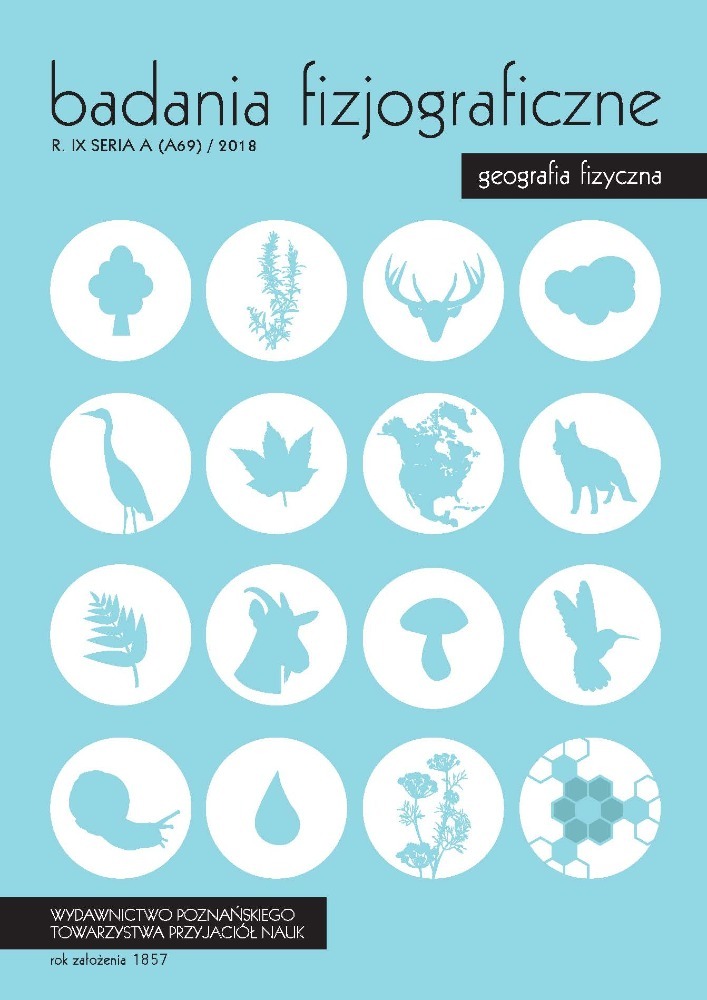Abstrakt
The study presents the characteristic of annual, seasonal and diurnal course of cloudiness in Poland in 2001–2016. The analysis was performed on 28 meteorological stations (IMGW-PIB); the data came from threefold climatological observations. Based on the data, the average course of annual, seasonal and diurnal cloud cover, maximum and minimum values were estimated. Moreover, the average number of characteristic nephological days during the year was calculated. The analysis confirmed a decrease in cloudiness in the spring and in the summer accompanied by an increase in the autumn and in the winter season. Furthermore, in the summer the values of diurnal cloud variation were higher in the summer than in the winter. August was the least cloudy month (56%) while December proved most cloudy (79%). During the entire period in question, the Pomeranian Lakeland was most clouded while the Szczecin Shore Zone proved the least cloudy.
Bibliografia
Adamczyk R., Ustrnul Z., 2006: Rola cyrkulacji atmosferycznej w kształtowaniu zachmurzenia na obszarze Polski, Ann. UMCS, Sec. B, 59(1), 15–23.
Bartok B., Imecs Z., 2012: Verification of statistical cloudiness estimations for Europe, Aerul şi Apa. Componente ale Mediului, numer?? 289–296.
Boucher O., Randall D., Artaxo P., Bretherton C., Feingold G. Forster P., Zhang X.Y., 2013: Clouds and aerosols, [w:] T.F. Stocker, D. Qin, G.-K. Plattner, M. Tignor, S.K. Allen, J. Doschung, A. Nauels, Y. Xia, V. Bex, P.M. Midgley (eds), Climate Change 2013, The Physical Science Basis, Contribution of Working Group I to the Fifth Assessment Report of the Intergovernmental Panel on Climate Change, Cambridge Univ. Press, 571–657.
Degirmendžić J., Kożuchowski K., Żmudzka E., 2004: Changes of air temperature and precipi tation in Poland in the period 1951–2000 and their relationship to atmospheric circulation, Internat. Journ. of Clim., 24, 3, 291–310.
Filipiak J., Miętus M., 2009: Spatial and temporal variability of cloudiness in Poland, 1971–2000, Internat. Journ. of Clim., 29, 1294–1311.
Gluza A.F., Kaszewski B.M., 2007: Wieloletnie zmiany zachmurzenia ogólnego w Lublinie (1947–2005), [w:] K. Piotrowicz, R. Twardosz (red.), Wahania klimatu w różnych skalach przestrzennych i czasowych, UJ, Kraków, 355–364.
IPCC, 2007: Climate Change 2007, [w:] S. Solomon, D. Qin, M. Manning, Z. Chen, M. Marquis, K.B. Averyt, M. Tignor, H.L. Miller (eds), The Physical Science Basis. Contribution of Working Group I to the Fourth Assessment Report of the Intergovernmental Panel on Climate Change, Cambridge Univ. Press, Cambridge, United Kingdom and New York, NY, USA.
Lorenc H. (red.), 2005: Atlas klimatu Polski, IMGW, Warszawa.
Matuszko D., 1992: Wpływ cyrkulacji atmosfery na zachmurzenie w Krakowie, [w:] A. Marsz, A. Styszyńska (red.), Oscylacja Północnego Atlantyku i jej rola w kształtowaniu zmienności warunków klimatycznych i hydrologicznych Polski, Akad. Morska w Gdyni, Gdynia, 141–146.
Matuszko D., 1997: Okresy o największym i najmniejszym zachmurzeniu w Krakowie w latach 1906–1995, [w:] Ekstremalne zjawiska meteorologiczne, hydrologiczne i oceanograficzne, Symp. Jubileuszowe PTGeof., Warszawa, 103–106.
Matuszko D., 2003: Cloudiness changes in Cracow in the 20th century, Internat. Journ. of Clim., 23, 975–984.
Matuszko D., 2007: Zmienność zachmurzenia na podstawie krakowskiej serii obserwacyjnej (1863–2005), [w:] K. Piotrowicz, R. Twardosz (red.), Wahania klimatu w różnych skalach przestrzennych i czasowych, UJ, Kraków, 347–354.
Matuszko D., Węglarczyk S., 2018: Long-term variability of the cloud amount and cloud genera and their relationship with circulation (Kraków, Poland), Internat. Journ. of Clim., doi.org/10.1002/joc.5445.
Niedźwiedź T., Ustrnul Z., 1989: Wpływ sytuacji synoptycznych na kształtowanie się zachmurzenia w Hornsundzie, XVI Symp. Polarne, Wyd. UMK w Toruniu, Toruń, 158–160.
Okołowicz W., 1962: Zachmurzenie Polski, Pr. Geogr., 34.
Okoniewska M., 2016: Dobowy przebieg zachmurzenia w Polsce w kolejnych dekadach roku (na przykładzie lat 1990–2000), Journ. of Ed., Health and Sport, 6(10), 730–740.
Stenz E., 1952: Zachmurzenie Polski, Przegl. Meteor. i Hydrol., 1–2, 69–81.
Szyga-Pluta K., 2002: Częstość występowania rodzajów chmur w Polsce Północno-Zachodniej, ad rem, Poznań.
Szyga-Pluta K., 2015: Circulation influence on cloudiness in Poznań, Quaes. Geograph., 34, 3, 141–149.
Tamulewicz J., 2000: Zachmurzenie nieba w Poznaniu na tle typów cyrkulacji atmosfery, Bad. Fizjograf. na Pol. Zach., Ser. A – Geogr. Fiz., 51, 133–146.
Warakomski W., 1961: Częstotliwość występowania rodzajów chmur w Polsce w okresie 1950–1959, Ann. UMCS, Ser. B, 7, 11, 207–256.
Warakomski W., 1969: Zachmurzenie i rodzaj chmur w zależności od mas powietrza w Polsce, UMCS, Lublin [rozpr. hab.].
Wibig J., 2008: Cloudiness variations in Łódź in the second half of the 20th century, Internat. Journ. of Clim., 28(4), 479–491.
Woś A., 2010: Klimat Polski w drugiej połowie XX wieku, Wyd. Nauk. UAM, Poznań.
Żmudzka E., 2005: Pole ciśnienia nad Europą i północnym Atlantykiem w sezonach i latach o anomalnym zachmurzeniu nad Polską, Woda–Środowisko–Obszary Wiejskie, 5(14), 393–410.
Żmudzka E., 2007a: Cloudiness over the north-western Poland, Quaes. Geograph., 26A, 77–85.
Żmudzka E., 2007b: Przyczyny cyrkulacyjne zmian zachmurzenia nad Polską (1951–2000), [w:] K. Piotrowicz, R. Twardosz (red.), Wahania klimatu w różnych skalach przestrzennych i czasowych, UJ, Kraków, 93–102.
Żmudzka E., 2007c: Zmienność zachmurzenia nad Polską i jej uwarunkowania cyrkulacyjne (1951–2000), Wyd. UW, Warszawa.
Żmudzka E., 2012: Nefologiczne dni charakterystyczne – różne kryteria wydzielania i ich wpływ na wyniki badań, Przegl. Geofiz., 1, 21–33.
Licencja
PTPN ma prawa autorskie do tytułu czasopisma
 https://creativecommons.org/licenses/by-nc-nd/4.0/
https://creativecommons.org/licenses/by-nc-nd/4.0/
